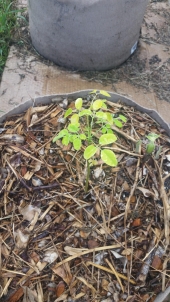Thanks for the replies and interest. I should say here that we are still very much in the learning and experimenting process, and will no doubt make many more changes before we have this system perfected for our conditions. Hopefully you can learn from and build on our experiences as we go, as we have on that of others.
Miles, let me address you questions first.
The KNF tradition has developed a number of recipes for culturing locally occurring beneficial microbes. The resulting cultures are used in a variety of ways: in livestock feed (to improve gut flora and aid in digestion), on crops (to combat bacterial and fungal attacks, or to trigger certain plant growth responses), and on animal bedding. In this last use, the microbes are used to alter or speed up the decomposition process at work in the bedding. By culturing beneficial microbe X and then applying it onto the bedding, its is hoped that microbe X will become a backbone of the microbial community. This helps to ensure that any animal wastes start breaking down aerobically as soon as they hit the bedding. You may be familliar with EM (effective microorganisms), commercially produced microbial solutions that are marketed for these and similar applications. The recipes used by KNF aim to culture local strains of these same microbes - often referring to them as IMOs (Indigenous Microorganisms) - using commonly available materials.
Now, this is not to say that deep litter couldn't function without these inoculations. We've never not inoculated, so I can't say for sure. The indigenous microbes we are culturing are, assumedly, already present to some degree in the very bedding we are using, assuming we source it locally. Theoretically, then, this system should work without inoculation, assuming all the conditions are ideal. However, the KNF guys who have been doing this for years or decades recommend inoculating not only to start, but also whenever a problem occurs (like smells going south). Though we've never done any standardized tests, we've been happy with the results when we have applied these sprays/mixtures, in terms of kick-starting the kinds of decomposition we are looking for.
The cultures that we have used on our pig system are (recipes in the links):
1. Fermented rice bran (yeasts and white mold). This is similar to I.M.O. 3 in KNF
recipes.
2. Lactic acid bacteria spray -
LAB
3. Fermented plant juice -
FPJ
Lactic acid bacteria spray is especially renowned for speeding up decomposition and turning an anaerobic process into an aerobic one (assuming air is also present).
Maureen: We don't typically harvest compost from the litter during a pig cycle. After one or two cycles, you can start harvesting compost and replacing it with fresh bedding (though this is not required). Otherwise, it's just a matter of adding fresh bedding material as the litter settles, decomposes, or develops a problem (like getting wet!). As far as feed goes... I'll dedicate a post to that on another day. Stay tuned!
















